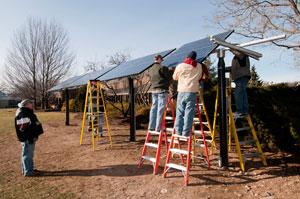Students' Solar Project Allows Firsthand Look at Energy Savings
Friday, April 30, 2010
 A grant-funded student project at Pennsylvania College of Technology is bringing today's "green" sensitivity to a campus landmark that celebrates Williamsport's lumber prominence in the 1800s.
A grant-funded student project at Pennsylvania College of Technology is bringing today's "green" sensitivity to a campus landmark that celebrates Williamsport's lumber prominence in the 1800s.
An array of photovoltaic panels has been installed just southwest of the college's Victorian House, a student-designed-and-built guest facility that was dedicated in June 1997. Penn College was one of a dozen institutions to receive a $15,000 Solar Scholars grant from the Sustainable Energy Fund (a private, nonprofit organization promoting energy efficiency, renewable energy and energy education) to introduce related studies into its curricula and convert an on-campus building to partial solar power.
The college sought, received and matched funding to reduce the carbon footprint of its Victorian House, which was chosen, said Wayne E. Gebhart, assistant professor of electrical technologies/occupations, because, "We thought it would be fun to take this new technology and set it next to a home from another century."
A more practical consideration was that the home already is equipped with a number of modern energy-saving features: "smart" controllers, variable air-volume systems and ground-source heat pumps.
"It's a grid-tied system, meaning it connects right to the breaker panel of the residence in this case, the Vic House," said Jeff B. Weaver, associate professor of electronics and computer engineering technology, and one of three faculty members who has nurtured the brainchild since its summer 2008 birth. "The panels connect to an inverter that turns the direct-current voltage into alternating-current voltage and then right into the breaker box."
The inverter has an interface that allows for integration with the Internet, collecting frequently updated data about power production, carbon-dioxide reduction and cost-savings for display online.
"It is technology from end to end," said Weaver, whose Tioga County home also employs photovoltaic panels, "and it is a novelty to watch your electric meter run backwards!"
The project had its roots in a conference at Dickinson College, where Weaver joined by Gebhart and Jon W. Hart, instructor of building automation technologies/HVAC/electrical first learned of the Sustainable Energy Fund grants.
Gebhart, who assumed some of the planning and implementation after the October death of Joseph M. Younes, an instructor of electrical technology/occupations, said the project provides a threefold benefit to the college.
"One, it's an excellent teaching resource," he said, noting the work has benefited varied majors in the schools of Construction and Design Technologies and Industrial and Engineering Technologies. Students not only installed the panels, but poured the concrete for the posts that anchor them, and the system will continue to serve a variety of curricular purposes.
"If students are thinking, "It's a nice day today; I wonder if our solar panels are generating any power?' they can access the Web from any classroom or laboratory and see what they're producing," Gebhart explained. "We can talk about it in our classes, then actually go and see it working."
The panels will benefit students in one of the college's newest majors: a two-year degree in renewable energy technologies that will help students develop the skills to install, troubleshoot and maintain photovoltaic, wind-turbine and solar-thermal systems.
"They also provide some power to the campus, adding to the students' understanding that solar is becoming more viable as the price comes down," Gebhart added. "And, it's a small sign that we're trying to think of the planet and about "green' technology."
For more about Penn College and its "degrees that work," visit on the Web, e-mail or call toll-free 800-367-9222.
For more information about grant-funding opportunities, faculty and staff may contact the Grants and Contracts Office at ext. 7562 or through its Web portal.
